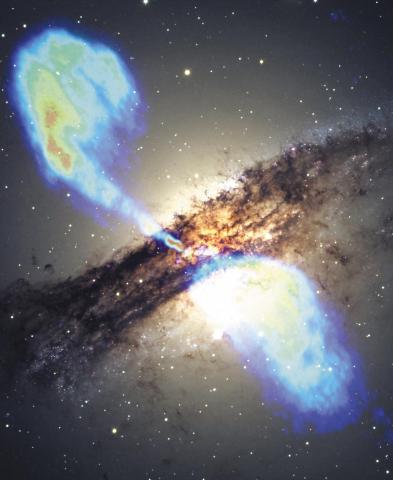

Astrophysics activities at Georgia Tech are devoted to interdisciplinary research and education linking astrophysics, astroparticle physics, cosmology, numerical relativity, and gravitational wave physics. Research focuses on extreme astrophysics such as mergers of black holes and neutron stars, central engines of active galactic nuclei, gamma ray bursts, and the sources of the highest energy neutrinos. Faculty that conduct astrophysics research at Georgia Tech form the Center for Relativistic Astrophysics (CRA).
- Astroparticle Physics: Georgia Tech's efforts in subatomic physics are in the area of experimental astroparticle physics. Astroparticle physics studies the most powerful objects in the Universe, such as pulsars, gamma ray bursts, supermassive black holes at the center of galaxies, and supernovas. Important questions that astroparticle physics helps to answer include the origin of cosmic rays, the acceleration of high-energy particles in astrophysical objects, tests of fundamental physics, the origin of dark matter, neutrino properties, etc. Our faculty, postdocs, and students collaborate in several large experiments to detect high-energy gamma rays and neutrinos, with activities ranging from data analysis to instrumentation. For more details, visit our website.
- Black Holes and Neutron Stars: Black holes and neutron stars are the most compact objects in the universe, where matter is packed to very high densities under the relentless force of gravity. They are ideal tools to study gravity at its most extreme as well as a variety of physical processes that often accompany them, such as accretion of gas and energetic interactions with their environment. At the CRA, we currently investigate several key open questions in this area of research.
- Computational Astrophysics: Dark matter, gravitational waves, black holes, neutron stars and neutrinos are just a few of the topics under consideration by the CRA faculty that require computational techniques. Computers allow us to solve complicated, coupled non-linear equations, track high-energy particles through the sky, and reproduce the Universe inside our virtual lab. The CRA uses the NSF XSEDE resources, the CRA cluster, Cygnus, and our Visualization Lab to explore some of the secrets of the Universe.
- Cosmology and Galaxy Evolution: The field of cosmology studies the universe in its entirety. The evolution of galaxies and their central black holes are particularly useful to understand both the relevant cosmological and galactic processes that shape galaxies over billions of years. The length scales involved in these processes can range from an atomic level, when studying atomic and molecular transitions that are important in star forming gas clouds, to the cosmological scale, where tidal forces from distant galaxies create the initial rotation of a galaxy.
- Exoplanets: Planets beyond our own Solar System. So far, thousands have been detected, and a large number of them show very different properties from those in our own Solar System. This challenges our classical understanding of planetary formation. At the CRA, we study the dynamical origin of planetary systems, which can explain many of the observed puzzles. In addition, we investigate the habitability of these planets based on their dynamical interaction in order to better understand the prevalence of life in the universe.
- Gravitational Physics: Gravity is one of the four fundamental interactions of nature. Yet some of the most interesting predictions of the theory that governs gravitational interactions, General Relativity, allude direct detection. Black Holes and Gravitational Waves are both results of General Relativity.
- High-Energy Astrophysics: High-energy astrophysics is the study of fundamental physics within the most violent environments imaginable. X-ray and gamma-ray sources are used as laboratories to explore physical processes at temperatures, densities, and energies so extreme that Earth-based experiments would be impossible. This type of research can therefore provide direct tests of many of the basic ideas of modern physics.
| Name | Research Interests | Research Website |
|---|---|---|
| David Ballantyne |
high-energy astrophysics; accretion disks; galaxy and black hole evolution My research concentrates on topics in high-energy astrophysics with an... |
Research/Teaching Website |
| Tamara Bogdanović | My research interests are in astrophysics of some of the most massive black holes in the universe, a.k.a., supermassive black holes. Within my group... | Research website |
| Laura Cadonati | I joined the Center for Relativistic Astrophysics at GeorgiaTech in January 2015, from the University of Massachusetts Amherst. My principal research... | Research Website |
| Gongjie Li |
Dynamics of Exoplanets; Interactions between supermassive black holes and surrounding stars |
Research Website |
| A. Nepomuk Otte |
Astroparticle Physics, Instrumentation, Photon detectors |
otte.gatech.edu |
| Feryal Özel | ||
| Dimitrios Psaltis | My research focuses on understanding the properties of black holes and testing the theory of general relativity across many astrophysical and... | Research Wedsite |
| Surabhi Sachdev | ||
| Eden Schapera |
Experimental astrophysics research and instrumentation development |
|
| Sven Simon |
Space plasma physics/theoretical physics Magnetospheres of the outer planets, large-scale magnetospheric dynamics Moon-magnetosphere interactions... |
GT Space Plasma Physics Group |
| Ignacio Taboada |
Neutrino Astrophysics with IceCube. We are currently witnessing the birth of a new branch of astrophysics: high-energy astrophysics. With neutrinos... |
Taboada's Research Page |
| John Wise | Computational astrophysics – Star and galaxy formation, Supernovae, Black hole evolution I study the intricacies of both the distant and nearby... | Computational Cosmology Group |


